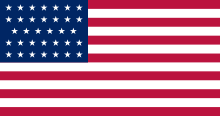1st Colorado Cavalry Regiment
| 1st Colorado Volunteer Cavalry Regiment | |
|---|---|
|
Flag of the United States, 1861-1863 | |
| Active | November 1862 to November 1865 |
| Country | United States |
| Allegiance | Union |
| Branch | Cavalry |
The 1st Colorado Cavalry was formed in November 1862 by Territorial Governor John Evans, composed mostly of members of the 1st Colorado Infantry and of C and D Companies of the 2nd Colorado Infantry. It was formed both to protect Colorado against incursions from the Confederate forces and to fight the Native Americans who already inhabited the area.
Command of this unit was given Colonel John Chivington, who had distinguished himself at the Battle of Glorieta Pass in the New Mexico Territory early in 1862, against Confederate forces. The 1st Colorado Cavalry would go on under Chivington to perpetrate one of the most shameful slaughters of American Indians in history, the Sand Creek Massacre.
Sand Creek Massacre
In early 1864, the 1st Colorado Veteran Volunteers (aka the Veterans Battalion) appears to have initiated the Colorado War by attacking Cheyenne Indians at Fremont's Orchard. The resulting hostilities and Indian retaliations brought traffic on the wagon trails into Denver to a standstill.
Peace negotiations were in progress, and encampments of Cheyenne and Arapaho Indians on Sand Creek had been assured by the US Government that they would not be attacked.
Instead, in what is known as the Sand Creek Massacre, Chivington and his troops struck in November 1864, a dawn attack that massacred an estimated one-quarter of the Indian encampments, mostly old men, women, and children. Body parts were taken as souvenirs and this event was the basis of the slaughter of an Indian village in the movies Soldier Blue and Little Big Man. Initial reports of the battle were taken as a victory in the US, but as details came out, opinions changed. A subsequent Congressional investigation resulted in a scorching castigation of the event, Colonel John Chivington, and the 1st Colorado Cavalry.
